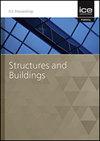带两支腿的钢筋混凝土墙的能量评价
IF 1.4
4区 工程技术
Q3 CONSTRUCTION & BUILDING TECHNOLOGY
Proceedings of the Institution of Civil Engineers-Structures and Buildings
Pub Date : 2023-02-02
DOI:10.1680/jstbu.21.00046
引用次数: 0
摘要
本文比较了在正向性近断层和普通远断层地震作用下,具有两个屈曲约束支撑外伸臂的钢筋混凝土核心墙体系的不同耗能形式。第一支腿的水平固定在顶部,第二支腿放置在不同的水平上。在非线性模型中,考虑了扩展塑性铰(EPH)方法和4塑性铰(4PH)方法。在4PH方法中,只允许在RC核心墙中使用4个塑料铰链,一个在基地,另一个在顶部支腿下方相邻,另外两个在相邻的第二支腿的水平。对于EPH方法,塑性可以扩展到岩心壁的任何位置。主要是对于EPH方法,在核心墙的底部、顶部支腿附近以及第二级支腿的上下,由于地震荷载引起的大力矩需求,产生了更多的非弹性能量需求。对于EPH和4PH两种方法,从远断层记录得到的基底非弹性能量的平均值几乎是NF记录的1.5倍。本文章由计算机程序翻译,如有差异,请以英文原文为准。
Energy based assessment of the reinforced concrete walls with two outriggers
In this paper, different kind of energy dissipation in reinforced concrete (RC) core-wall systems with two buckling-restrained braced outriggers subjected to forward directivity near-fault and ordinary far-fault earthquakes has been compared. The level of the first outrigger is fixed at the top and the second outrigger is placed at different levels. In the nonlinear model, two approaches for the RC core-wall were considered: extended plastic hinge (EPH) approach and 4 plastic hinges approach (4PH). In 4PH approach, only 4 plastic hinges are allowed in the RC core-wall, one at the base, one another adjacent beneath the top outrigger, and two others at the levels adjacent second outrigger. For EPH approach, the plasticity can extend anywhere in the core-wall. Principally for the EPH approach, at the base of core-wall and adjacent to top outrigger as well as above and below of second outrigger level, more inelastic energy demands are occurred due to large moment demand resulting from seismic load. On average for both EPH and 4PH approaches, the inelastic energy at the base from far-fault records is almost 1.5 times the corresponding value from NF records.
求助全文
通过发布文献求助,成功后即可免费获取论文全文。
去求助
来源期刊
CiteScore
3.40
自引率
6.20%
发文量
61
审稿时长
12 months
期刊介绍:
Structures and Buildings publishes peer-reviewed papers on the design and construction of civil engineering structures and the applied research associated with such activities. Topics include the design, strength, durability and behaviour of structural components and systems.
Topics covered: energy conservation, people movement within and around buildings, strength and durability of steel and concrete structural components, and the behaviour of building and bridge components and systems

 求助内容:
求助内容: 应助结果提醒方式:
应助结果提醒方式:


